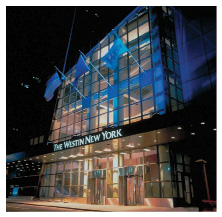- Home
- Media Kit
- Current Issue
- Past Issues
- Ad Specs-Submission
- Ad Print Settings
- Reprints (PDF)
- Photo Specifications (PDF)
- Contact Us

![]()
ONLINE

Editors' Note
Having held her current post since May 2009, Nancy London began her career in hospitality marketing at Starwood Hotels & Resorts in 2001. Before joining Starwood, she held various marketing management positions for publishing companies including Bantam Doubleday Dell, Time Inc., and International Masters Publishers Inc. She is a graduate of the University of Pennsylvania.
Company Brief
Westin is a lifestyle brand competing in the upper-upscale sector worldwide. Westin garnered praise with its famous Heavenly Bed ® and Heavenly Bath ® and launched a multimillion-dollar retail program featuring these products. Westin is the first global brand to offer in-room spa treatments at every hotel and the first to go smoke-free in North America, and its SuperFoods ® menu offers foods considered best for providing health-enhancing benefits. Starwood Hotels & Resorts Worldwide, Inc. (www.starwoodhotels.com), with 1,000 properties in nearly 100 countries and territories, is a fully integrated owner, operator, and franchisor of hotels, resorts, and residences with internationally renowned brands, which includes Westin, as well as St. Regis, Le Méridien, and Sheraton.

Westin Pune Koregaon Park, India
Westin has the advantage of a very strong heritage. It was started by two rival hoteliers in Seattle, quickly became the first U.S. hotel management company, and expanded internationally to Mexico and Canada. All the while, it has maintained a strong sense of consistency. There are certain innovations that the company came out with that were not branded, but were firsts for the hotel industry, including guest reservation systems, hotel credit cards, and family plans. As time went on, that was viewed as an opportunity to brand certain programs, products, and services, which started with the Heavenly Bed in 1999, and that has offered a distinct competitive advantage. That commitment to innovation and consistency has been key, as well as making sure that every Westin hotel, no matter where it is in the world, has certain core elements that are distinguishing features and are competitively differentiating.
Our goal in every product service we have is to help our guests maintain their wellness while on the road. For example, the Heavenly Bed, which offers an incredible night’s sleep, recognizes the importance of sleep to a healthy lifestyle.
Following the Heavenly Bed was the Heavenly Bath, which offers a wonderful sensory bath experience to enhance overall well being.
SuperFoods is a core program based on the idea that there are 24 superfoods readily available that can be combined in certain ways that offer even more health benefits than they do on their own. We have incorporated those into a breakfast menu and we’re looking to expand that into other touch points at the hotels.
There are four key areas we’re focusing on moving forward. The first is centered on sustainability because in order to maintain your own wellness, you need a healthy environment. We’re looking at ways to green our hotels with things like a new Heavenly low-flow shower head, or introducing dispensers in our showers as opposed to the plastic bottles.
Another area is design, which has also been core to the brand. We’ve done a great job in our guestrooms and our focus is now on how to bring more buzz to our public space. We are taking learnings from our sister brands, like W and Sheraton, and trying to drive a similar energy in the lobby.
We’re also thinking about how to take food and beverage to the next level with healthy meal offerings via small plates so you’re less likely to indulge, or keeping everything on the menu under a certain number of calories.
The fourth area is fitness, which is very much the foundation of wellness. We have WestinWORKOUT gyms, which we launched in 2003. Up until that point, hotel fitness centers were more of an afterthought. Westin changed that dynamic, and our hotels have wonderful fitness centers today with a sizeable footprint in most locations. While we’re very pleased with that as the core offering, we’re looking at adding additional services such as helping our guests do quick workouts in-room to ready them for sleep, or making it easier for them to rest if they’re really jet-lagged.

Westin New York at Times Square
“This is how it should feel” campaign started in 2006, and was the outgrowth of a lot of work that was done at Starwood at the time around branding. The idea was to drive an emotional connection with our guests through our products and services, as well as communicate it in a way that is highly differentiated for the industry. We wanted to rise above the sea of sameness and have marketing and advertising that was unique, different, and compelling.
As an example, we did inserts with our White Tea scent, which you’ll experience in our public spaces. It wasn’t a page ad, but a scent strip, so it really stuck out. It got at this idea of, “This is how it should feel,” and gave that emotional connection that would hopefully remind a guest of Westin.
Westin has been able to successfully differentiate by maintaining its commitment to consistency at the hotel level, and not compromising the guest experience to cut costs. From a marketing perspective, we’ve differentiated ourselves by leveraging tactical offers. The Amazon.com store front we’ve created is actually tied to a promotional offer. We’re offering guests a $100 gift card for staying two times in a Westin; this card can be used on Amazon.com, and hopefully at our wellness store. It’s a nice way to take a tactical effort that drives revenue without putting it in the bucket of 30 or 50 percent off. The idea of wellness, which is a white space that nobody occupies well today, is a huge opportunity for Westin.
It’s crucial. Not coming from a hotel background was, in many ways, the biggest challenge but also the biggest opportunity for me. While I brought more of a pure marketing background, it was an opportunity to have fresh eyes and a different viewpoint in an area that was often needed and welcome. By the same token, it was critical for me to understand that, while something may be a really great idea, we perhaps couldn’t do it for certain reasons, and then try to figure out a way to make it work. It was a lot of learning for me, but I enjoyed getting to know our general managers and operators, and understanding the realities. Not being in touch with that would be a huge miss on my part.•